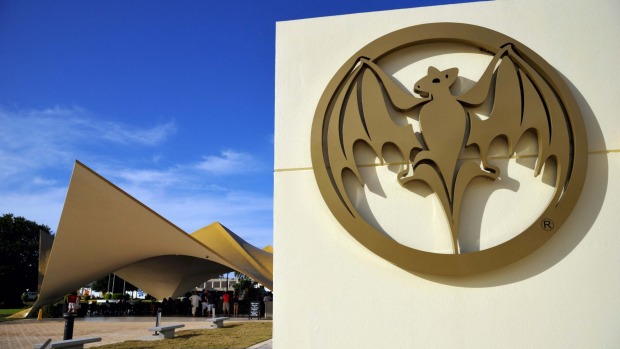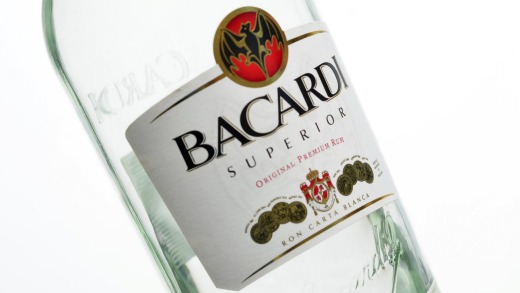
It occurs to me almost immediately upon entering the Bacardi Rum Distillery in Catano, Puerto Rico, that I may have just stepped into some sort of religious building.
The expansive entrance is empty and hushed as our tour group files in, our collective gaze automatically drifting skywards to the arched, fresco-covered ceiling. Like stained-glass windows, a history of rum is illustrated in colourful mosaics on each wall, and in lieu of religious statues, oak barrels and historical relics fill each corner. At the centre of it all is the altar of Bacardi: an enormous iron statue of a bat, wings outstretched, demanding worship.
"You are on sacred ground," our tour guide solemnly says. "We call this the Cathedral of Rum – the largest rum distillery in the world."

It's 9.40 am, we're 10 minutes into our hour-long tour of the distillery, and we've already had one cocktail each (free with a $12 ticket). Having come straight from the bar, located opposite the ticket sales counter, half our group is already lightly sloshed. We're off to a good start.
From the majestic entrance foyer, we're ushered into a screening room for a short movie about the history of Bacardi, and I brace myself for some shameless brand propaganda, but the film turns out to be pleasantly fascinating, and I'm surprised to discover that the rum that's so proudly Puerto Rican ("aged, filtered and blended in Puerto Rico," every bottle reads) was actually created in Cuba by a Spaniard.
A Catalan businessman, Don Facundo Bacardi Masso, opened Bacardi's first distillery in Santiago in 1862. (It was overrun by fruit bats drawn to the scent of the fermenting molasses, hence the logo). It was in Santiago, not Catano, that the business flourished and expanded for nearly a century until operations were nationalised by Fidel Castro and the family was forced into exile.
As a testament to their grit and resilience, the Bacardi family was able to start again, after losing their distilleries and most of their assets to Castro, and today, Bacardi's ritzy, Mies van der Rohe-designed corporate headquarters are in Bermuda. Most of the manufacturing, however, occurs in Catano.
"You're standing in the place where 85 per cent of all the Bacardi in the world is produced," our guide says ,as we're led into an impressive replica of Don Facundo's humble first distillery, bats and all.
Step by step, we're taken through the process of creating Bacardi rum: two types of fermentation, distillation, ageing and then blending. We learn there is rigorous quality control at every step, with more than 200 control tests done, not including the final testing and tasting before bottling. The formula or final blend is a secret, known only by Jose Gomez, maestro del ron.
After our lesson, we sniff our way through an interactive display that shows a multitude of Bacardi varieties and blends. Then we're brought into an art-deco-style bar for a basic mixology class, where we get a lesson on making basic cocktails, such as the mojito and Cuba Libre (rum and coke).
Those who signed up for the mixology tour ($35) are then admitted into the famed Bacardi University, a series of classrooms in which more in-depth mixology lessons are taught, and the rest of us are whisked into the distillery itself. It's an impressive sight – 20 fermentation tanks, spanning 4½ storeys high, each holding about 200,000 litres of liquid to be distilled in copper, cast-iron and stainless-steel columns. Later, the rum will be aged in oak barrels – a whopping 460,000 of them at any given time.
"We produce over 100,000 litres of rum every 24 hours," our tour guide says as we gawk.
The last stop is a rum tasting at the university, after which the tour would normally end. However, I'm keen to see one of the 25 ageing warehouses that we got a glimpse of from the distillery building, so I reach out to Bacardi's hospitality director, Ivan Puig Gonzalez, to see if I can get a peek inside. Later that day, I'm on a golf cart, wearing a neon vest and hard hat, heading to one of the ageing warehouses.
"For safety purposes, we can't take full tour groups into the warehouses," says Juan Cartagena, a brand manager who has offered to show me around. "Think about it: we have 85,000 barrels stored in each warehouse, stacked floor to ceiling, side to side. It's too much of a safety hazard to bring people through. The alcohol fumes make it additionally dangerous."
He wasn't kidding about the fumes. My eyes begin to water upon entering the warehouse. The air somehow feels flammable, which it is, I'm assured, and the fumes only intensify the further you step inside. I opt to stay at the entrance, nearest the oxygen, where to my surprise I'm joined by the keeper of the barrels: Gomez, the maestro del ron himself. "Call me Joe," he insists, and to my delight he proceeds to give me a long lesson on the ageing process of rum, too detailed to document here.
"We have barrels that are one year old, and we have barrels that are 25 years old," he says, pointing out the bronze medallions on the side of each barrel. A different year is neatly engraved on each medallion. "In case of fire, we never, ever keep barrels of the same age all in the one warehouse."
My curiosity satiated and properly indoctrinated on the ageing process, I'm whisked back to the bar opposite the ticket counter, where I started. I grab a final mojito for the road and prepare for the short journey back to San Juan, but I'm stopped by one of the bar staff.
"You forgot your souvenir," I'm told, and a small parcel is pushed into my hands. I open it. It's a cup that resembles a chalice, emblazoned with the Bacardi logo. But of course.
The Bacardi Rum Distillery is at Carretera 165, Catano, Puerto Rico. Tours are available seven days a week, Monday to Saturday 9am-6pm (last tour at 4.30pm), and Sunday 10am-5pm (last tour at 3.45pm). Phone +1 787 788 8400 or see casabacardi.org.